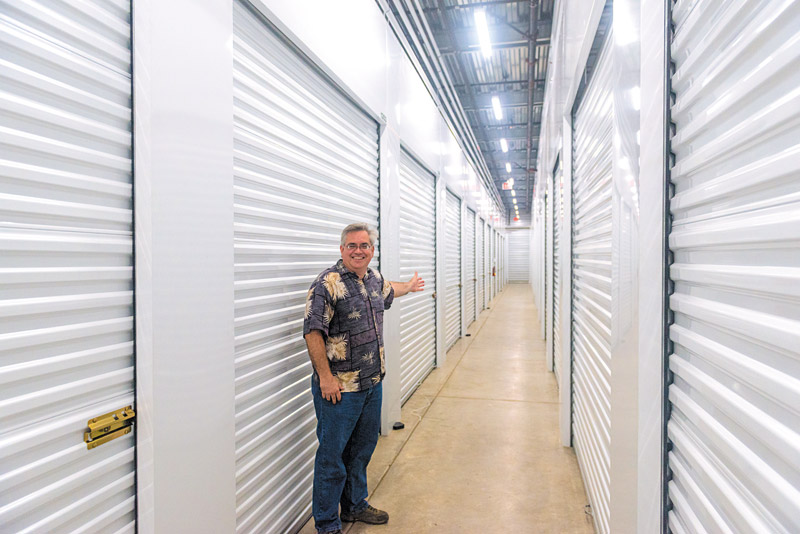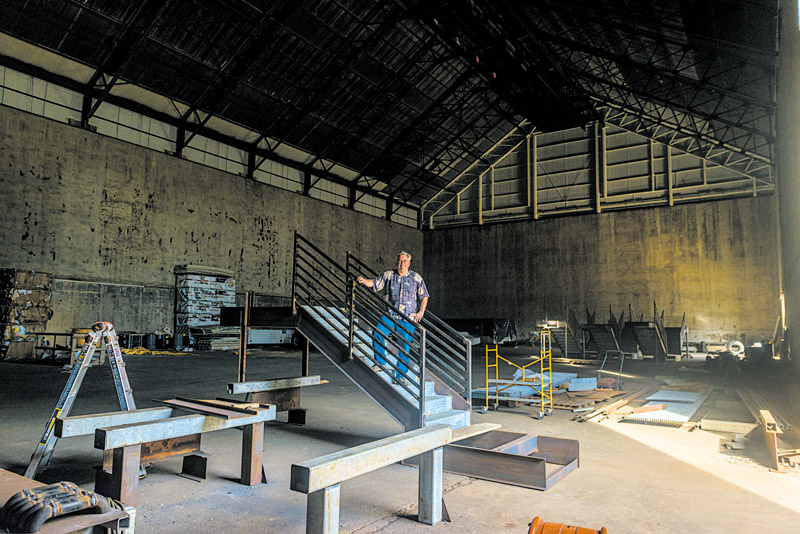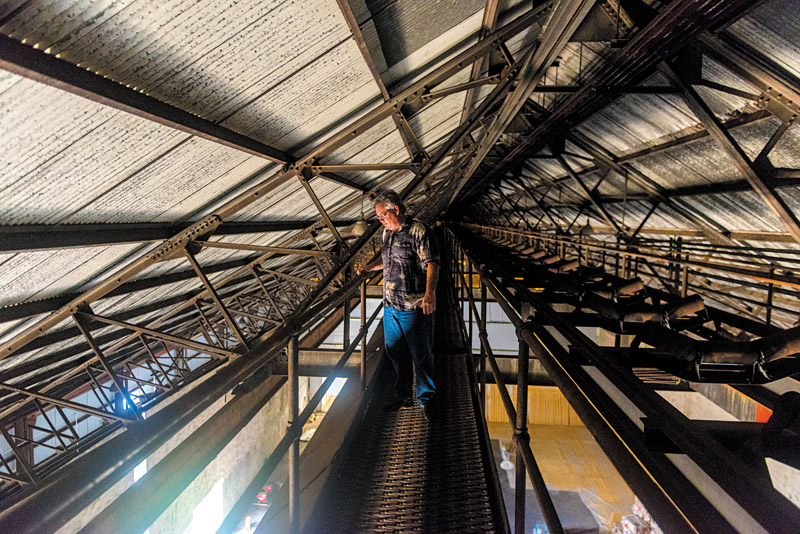Guarding Kauai’s Great Story
Sugar cane is a big part of the Garden Isle’s past, and Guardian Self Storage, which took over the former Nawiliwili Bulk Sugar Storage Facility in 2016, aims to perpetuate that era in its modern business model.
There’s barely any light trickling into the vast unfinished portion of the former Nāwiliwili Bulk Sugar Storage Facility, but you can still make out dark splotches of molasses embedded in the towering concrete walls.
“That’s after power washing and power washing,” says Thomas Lambert, co-owner of Guardian Self Storage. His company purchased the property in 2016 and is in the process of completely renovating the historic site.
Stained forever by the mounds of raw sugar that were once stored here, these walls would have plenty to say if they could talk. They were witness to all sorts of action in past decades, always piled several stories high with sugar that awaited exportation to locations around the globe. Remnants of these days of yesteryear still exist in various forms throughout the structure, which is only one-third completed thus far, like those blotchy patches on the walls that serve as a reminder of an industry that once dominated the island.
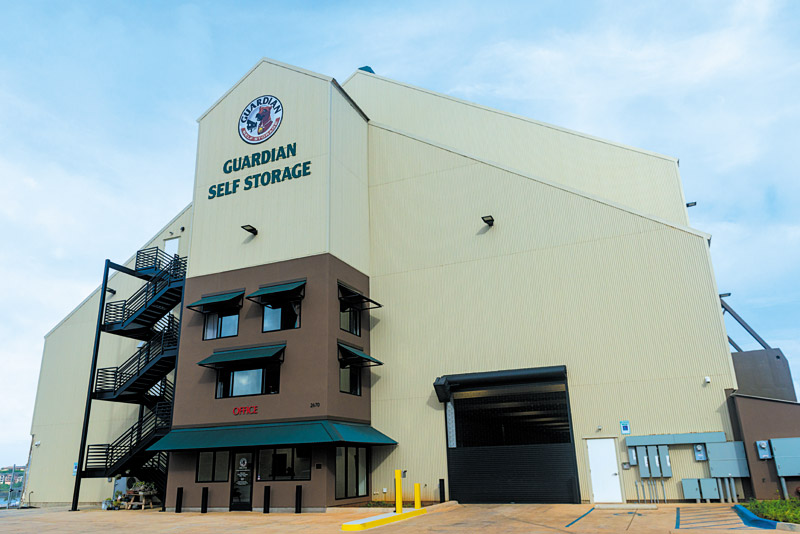
Guardian Self Storage co-owner Thomas Lambert walks through the former Nāwiliwili Bulk Sugar Storage Facility. Part of the area has been renovated into self-storage units , while the other still remains untouched.
The warehouse functioned as Kaua‘i’s only export facility for sugar cane enterprises from 1950 to 2010. Prior to beginning the conversion of the property into a storage facility for people’s personal belongings, a mountain of sugar filled the empty space.
Back in the day, large trucks would carry as much as 21 tons of sugar from operations like Līhu‘e Mill. The sugar was poured into a hopper at the property’s site and conveyor belts would subsequently move it from the receiving or weigh station to the top of the warehouse via a long skinny structure that went from the ground to the building’s upper level. (The weigh station is still in operation for other resources, but the conveyor system leading into the building was dismantled in 2016.)
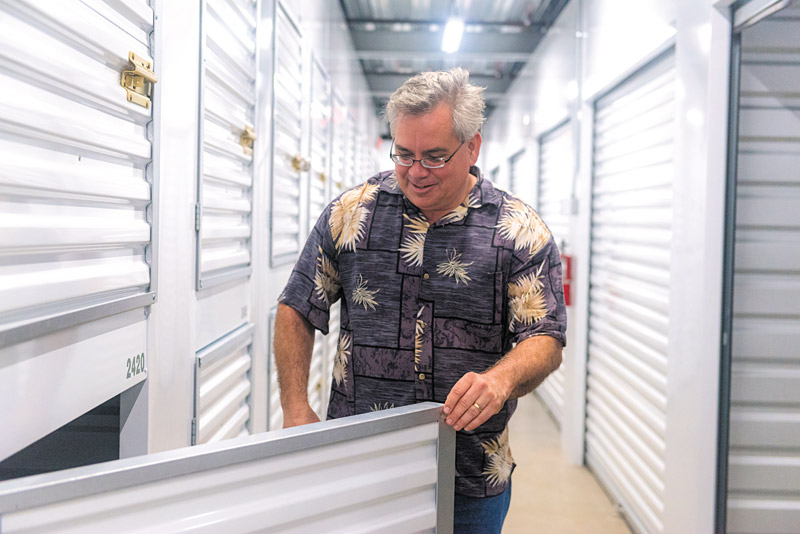
Guardian Self Storage co-owner Thomas Lambert walks through the former Nāwiliwili Bulk Sugar Storage Facility. Part of the area has been renovated into self-storage units, while the other still remains untouched.
Once inside, the sugar was carried and dumped in waterfall fashion onto various spots where it was stored until ready for export. When that time came, it was picked up and pushed by bulldozers into an underground hopper where it would then ride out on conveyor belts onto an awaiting ship.
After purchasing the building, Lambert was enamored by its former daily operations and enjoys sharing the information he’s learned from either historical records or anecdotal stories.
“I’m that type of person,” he says, noting his love for learning about Kaua‘i history.
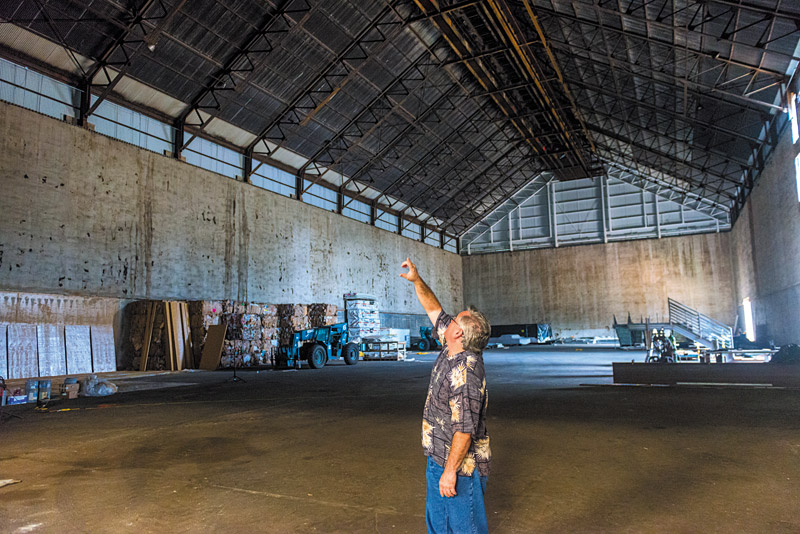
Thomas Lambert, co-owner of Guardian Self Storage, walks through the portions of the historic Nāwiliwili Bulk Sugar Storage Facility that haven’t yet undergone refurbishing. Plans are in the works to turn the warehouse into more storage units and even micro-apartments, all while keeping the skeleton and multiple structural attributes in tact.
As Lambert leads a tour of the building, he spouts off all kinds of interesting tidbits, like the fact that the building’s construction began in 1949 to the tune of $1 million. By the mid-1960s, more room was needed to accommodate an expanding sugar cane industry — many companies made use of the facility — and the roof was raised some 20 feet to hold the influx of sugar.
“Sugar plantations were huge at one time,” adds Fran Kalb, who manages Guardian Self Storage in Puhi.
The weight of the sugar, in fact, became so significant in the late 1960s that it caused one of the facility’s walls to collapse. Thankfully, no one was hurt, but after that, buttresses were added outside of the structure for support, along with other reinforcements like concrete. These structural enhancements have withstood the hands of time. Today, rather than support sugar storage, however, they serve as a foundation for people’s personal property.
“To take something and revitalize it and repurpose it to storage, but in a new form that serves us today in the world we live in now, is exciting,” says Kalb. “It has a function again after sitting for so long.”
The facility sat dormant for six years after Gay & Robinson ceased operations and prior to Guardian Self Storage’s purchase from the former sugar cane company in a couple of years ago. By the time the storage facility shut down in 2010, it was in great disrepair. The good news for Lambert was that its skeleton was still hearty, so repairs didn’t require a complete overhaul Rather, construction included various refurbishments like stripping and replacing the siding, as well as repainting.
The property currently totals around 60,000 square feet, one-third of which has been completely converted into a brand-new storage facility where people can rent out spaces that range from lockers to 10-by-30-foot rooms.
The second and third phases of the storage facility, which is one of Kaua‘i’s tallest buildings at four stories high, are already in the works, and may even include micro-apartments. But several of the structure’s former attributes will likely stay put, such as the catwalks perched at the top of the building where an operator used to stand and ensure that sugar fell to its appropriate location within the building.
But no matter what superficial changes take place, the history of sugar can never be permanently erased, as evidenced by the smears on the walls. Molasses has been discovered in all kinds of places since renovations started taking place, like outdoor pipes that used to run sugar in its liquid form onto boats.
“Sometimes you can still smell it when you’re up in the rafters,” says Lambert, who opened Guardian Self Storage’s original location in Puhi in 2006.
The sugar cane industry in Hawai‘i may have gone by the wayside, but the building will continue to serve a purpose — and a much-needed one at that. Before opening the new location in Nāwiliwili, Lambert had a waiting list of more than 100 people seeking storage space. But what will make this location stand apart from others, besides offering air conditioning and a dehumidifier, is that it will remain a historic landmark.
“We saw value in the existing building,” he says.
Even though people told him it would be more financially viable if he tore the building down and started over, and despite the hard work that was required to renovate, he was determined to turn what was once a marker of economic pride for the island into something functional again: a place that could not only be used for practical purposes, but would serve as a pleasant reminder of the bygone days of Kaua‘i’s plantation era.
Visit guardianselfstoragekauai.com for more information.

